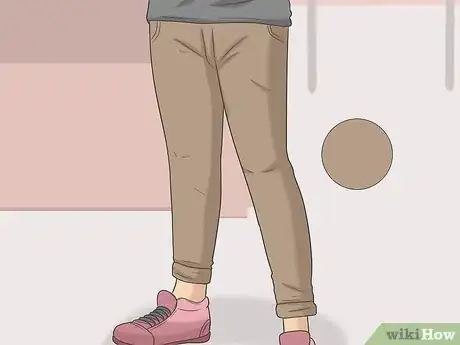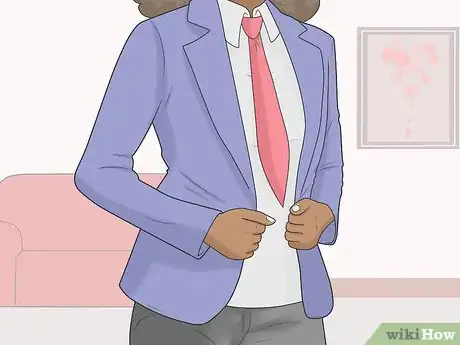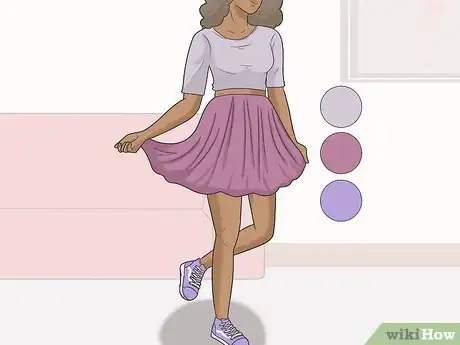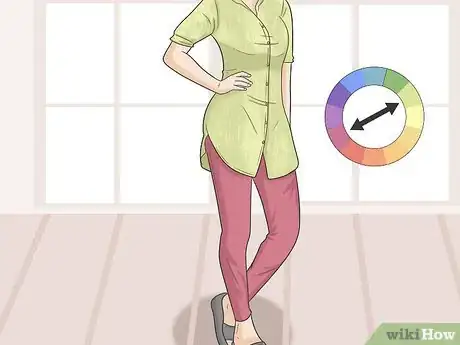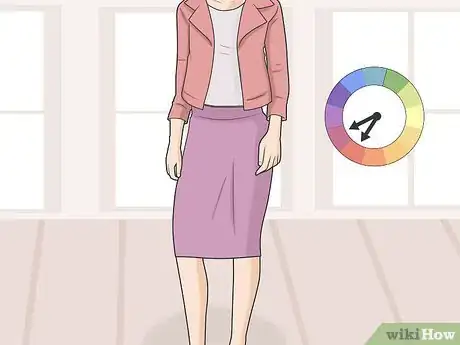This article was co-authored by Shelley Golden. Shelley Golden is the founder of Shelley Golden Style based in the San Francisco Bay Area. With over 20 years of fashion and visual arts experience, Shelley has worked for The International Academy of Merchandise and Design in Chicago, the Wellesley Historical Society, and at Bloom formerly: Image For Success. Shelley is a certified Color Consultant from The Image and Color Institute International and a Color Specialist Member of Color Designers International (CDI). Shelley holds a BS in Textile and Business from Arizona State University and was rated a Top Pro of 2018 by Thumbtack.
There are 10 references cited in this article, which can be found at the bottom of the page.
This article has been viewed 11,562 times.
The prospect of color matching your clothes can be intimidating, leading many to stick with simple black and white combinations to avoid clashing. However, if you start with neutral colors and mix in brighter statement colors one at a time or as part of complementary pairs, you’ll be adding stylish and attention-grabbing tones to your wardrobe in no time.[1]
Steps
Sticking with Neutrals
-
1Choose black, white, and grey basics for no-fail options. Since they have no hue, shades of black, white, and grey match all other colors. This makes them a great starting place when you’re trying to pull together an outfit. These colors can work as supporting pieces for bolder hues and also pair well with each other for no-fail outfits.[2]
- It’s generally easier to wear dark colors on the bottom and lighter hues on top. For a classic look, try black pants and a white shirt.
-
2Mix it up with shades of brown for a bit of variety. Although there are many different hues of brown, most act as neutral colors since they pair well with nearly all colors.[3] With shades ranging from beige to camel to chocolate, brown clothing makes a good and easy-to-match addition to most wardrobes.
- Light browns, such as beige, tan, khaki, and camel, are particularly easy to pair with other colors.
- Camel goes best with dark shades, like dark blue or dark red, as well as warm whites.[4]
- Traditionally, it’s been considered a faux pas to wear darker browns with black. However, this old rule has become less hard and fast in recent years.[5]
- Looking for a more exciting neutral? Try a shimmery or metallic bronze. Since it’s a shade of brown, it will still match with most other hues.[6]
Advertisement -
3Add in olive and navy as fashionable neutrals. Like brown, olive and navy are not technically neutral colors; however, since they both pair well with most other colors, they are often considered neutrals in the world of fashion.[7] A pair of olive pants or a navy blue jacket can mix up your collection a bit but will still match well with any other neutral color.
- Navy is traditionally not worn with black. However, similar to the no-brown-and-black-together guideline, many consider this rule to be outdated.[8]
Adding in a Single Color
-
1Try a single bright item for a pop of color.[9] This single hue can be a big piece (like a shirt or pants) or a small accessory (such as a belt or nail polish) depending on how much color you’d like to incorporate. As long as you keep the rest of your outfit neutral, you won’t risk clashing.
- For a classic example of adding color, try wearing a red tie with a white shirt, navy blazer, and khaki pants. For a bolder option, you could match a bright pink dress with nude heels and a camel purse.[10]
-
2Pair two shades of the same color. Light and dark variations of the same color often blend together well. To add a bit more depth to your look, try adding two shades of the same general color to an otherwise neutral outfit. For best results, wear darker versions of the color on parts you would like to downplay. Use lighter shades, which catch the eye first, on areas you’d like to play up.
- For example, you could pair a lavender shirt and royal purple tie with a suit in a neutral color like tan or grey.[11]
-
3Create a fully monochromatic look. To really up the ante on your color matching, dress head to toe in a single color with varying levels of brightness and saturation. This tonal method of dressing can help you incorporate more color into your everyday wardrobe without risking unflattering clashes.[12]
- For example, you could pair an orchid skirt with a lilac blouse. Add in violet shoes to complete the look.[13]
- Mix textures to give your single-hued look more depth and interest. Try wearing light blue linen pants with a chambray denim button up or a pink silk dress with a chunky bright salmon knit sweater.
Mixing Complementary Hues
-
1Use colors across from each other on the color wheel. A color wheel arranges the natural colors of red, orange, yellow, green, blue, indigo, and violet around a circle. To create a bold look with a contrasting pair, simply match a color with the shade opposite it on the wheel, such as blue with orange or green with red.[14]
- To try the contrasting combination of red and blue, you could pair a denim shirt with bright red pants, or a red dress with cobalt pumps.[15]
- If you’d like to create a less bold look, try mixing contrasting hue and brightness as well. So, for example, if your pants are a particularly bright and saturated kelly green, try going for a light faded red shirt.
-
2Pair analogous colors. Shades that are next to each other on the color wheel are known as analogous hues and create a flattering but less dramatic effect. These neighboring hues on either side of a specific color are easy matches, especially when they have similar saturation and brightness.[16]
- For example, you could pair a pink button down with red pants or a green dress with a yellow jacket.[17]
-
3Remember to match accessories made of leather and metal. Color matching should also extend to your accessories. As a rule, you should try to match similar leather colors with each other, pairing black with black and brown with brown. In general, you should also avoid mixing metals, keeping similar materials together (i.e. silver with silver and gold with gold).[18]
- In general, silver jewelry goes better with cooler hues, and gold jewelry goes better with warmer hues.[19]
- A little variation in texture is considered fine and a potentially nice mix. For example, you could try pebble-grained brown leather boots with a similarly-colored but smooth-textured belt and watch.
- If done properly and intentionally, some mismatched metals or leathers can be fashionably rule-breaking. However, you should aim to keep both styles and colors within the same general family. For example, pairing a light camel belt with dark brown leather shoes could be an interesting solution if implemented correctly.
Expert Q&A
Did you know you can get expert answers for this article?
Unlock expert answers by supporting wikiHow
-
QuestionWhat colors look best on Zoom?
 Shelley GoldenShelley Golden is the founder of Shelley Golden Style based in the San Francisco Bay Area. With over 20 years of fashion and visual arts experience, Shelley has worked for The International Academy of Merchandise and Design in Chicago, the Wellesley Historical Society, and at Bloom formerly: Image For Success. Shelley is a certified Color Consultant from The Image and Color Institute International and a Color Specialist Member of Color Designers International (CDI). Shelley holds a BS in Textile and Business from Arizona State University and was rated a Top Pro of 2018 by Thumbtack.
Shelley GoldenShelley Golden is the founder of Shelley Golden Style based in the San Francisco Bay Area. With over 20 years of fashion and visual arts experience, Shelley has worked for The International Academy of Merchandise and Design in Chicago, the Wellesley Historical Society, and at Bloom formerly: Image For Success. Shelley is a certified Color Consultant from The Image and Color Institute International and a Color Specialist Member of Color Designers International (CDI). Shelley holds a BS in Textile and Business from Arizona State University and was rated a Top Pro of 2018 by Thumbtack.
Personal Branding Image Consultant & Personal Stylist
-
QuestionHow can I incorporate color into my wardrobe?
 Kathi Burns, CPO®Kathi Burns is a board certified Professional Organizer (CPO) and Founder of Organized and Energized!, her consulting business with a mission to empower people to master their environment and personal image by assisting them in taking control, making change and organizing their lives. Kathi has over 17 years of organizing experience and her work has been featured on Better Homes and Gardens, NBC News, Good Morning America, and Entrepreneur. She has a BS in Communication from Ohio University.
Kathi Burns, CPO®Kathi Burns is a board certified Professional Organizer (CPO) and Founder of Organized and Energized!, her consulting business with a mission to empower people to master their environment and personal image by assisting them in taking control, making change and organizing their lives. Kathi has over 17 years of organizing experience and her work has been featured on Better Homes and Gardens, NBC News, Good Morning America, and Entrepreneur. She has a BS in Communication from Ohio University.
Board Certified Professional Organizer
References
- ↑ Kathi Burns, CPO®. Fashion Stylist. Expert Interview. 31 December 2019.
- ↑ https://www.apetogentleman.com/colour-match/
- ↑ Kathi Burns, CPO®. Fashion Stylist. Expert Interview. 31 December 2019.
- ↑ Shelley Golden. Personal Branding Image Consultant & Personal Stylist. Expert Interview. 10 July 2020.
- ↑ https://www.elle.com/fashion/trend-reports/a26417666/can-you-wear-brown-and-black-together/
- ↑ https://www.cosmopolitan.com/style-beauty/fashion/a5759/simple-ways-to-master-color-mixing/
- ↑ Kathi Burns, CPO®. Fashion Stylist. Expert Interview. 31 December 2019.
- ↑ https://www.cosmopolitan.com/style-beauty/fashion/advice/a19838/fashion-q-and-a-black-and-navy/
- ↑ Kathi Burns, CPO®. Fashion Stylist. Expert Interview. 31 December 2019.
- ↑ https://verilymag.com/2017/03/add-color-to-your-outfit
- ↑ https://www.realsimple.com/beauty-fashion/clothing/shopping-guide/color-matching?slide=216#216
- ↑ https://www.apetogentleman.com/colour-match/
- ↑ https://www.realsimple.com/beauty-fashion/clothing/shopping-guide/color-matching?slide=216#216
- ↑ https://www.apetogentleman.com/colour-match/
- ↑ https://www.cosmopolitan.com/style-beauty/fashion/a5759/simple-ways-to-master-color-mixing/
- ↑ https://www.collegefashion.net/fashion-tips/a-foolproof-guide-to-matching-colors-in-your-outfits/
- ↑ https://www.cosmopolitan.com/style-beauty/fashion/a5759/simple-ways-to-master-color-mixing/
- ↑ https://www.wsj.com/articles/should-a-mans-shoes-and-belt-always-match-1455736279
- ↑ Shelley Golden. Personal Branding Image Consultant & Personal Stylist. Expert Interview. 10 July 2020.
- ↑ https://www.wsj.com/articles/should-a-mans-shoes-and-belt-always-match-1455736279


